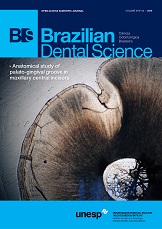Decoronation as an alternative procedure for dental ankylosis after dental reimplantation due to trauma in growing children: case report
DOI:
https://doi.org/10.14295/bds.2015.v18i3.1126Abstract
Dental ankylosis occurs by fusion of the root surface with the alveolar bone due to necrosis of the periodontal ligament. Local trauma, periapical infection, endocrine and metabolic disorders, excessive masticatory effort, poor eruptive force of the permanent successor and genetic alterations are some factors that can lead to ankylosis. Although there is not a known treatment for dentoalveolar ankylosis, there are alternative procedures, such as keeping the ankylosed tooth or its root, extraction followed by orthodontic closure, autotransplantation, implant, dento-osseous unit osteotomy or decoronation. The decoronation is a procedure which the crown of the ankylosed tooth is surgically removed below the cemento-enamel junction and the root is buried. After the procedure, a aesthetic maintainer of space is installed to prevent the space loss until the opportunity to provide a definitive rehabilitative treatment. Our aim is to report the case of patient LSM, female, 8 years-old, who came to the Oraldental Trauma Center of Federal University of Ceará after colliding against a wall. Avulsion of the dental element 21 occured and the tooth was stored in milk. The reimplantation occurred one hour after the injury. The treatment performed was decoronation and installation of a aesthetic and functional space maintainer. This case report presents a clinical follow-up of 6 months and 3 years of radiografic follow-up.
Downloads
Downloads
Additional Files
Published
How to Cite
Issue
Section
License
Brazilian Dental Science uses the Creative Commons (CC-BY 4.0) license, thus preserving the integrity of articles in an open access environment. The journal allows the author to retain publishing rights without restrictions.
=================




























